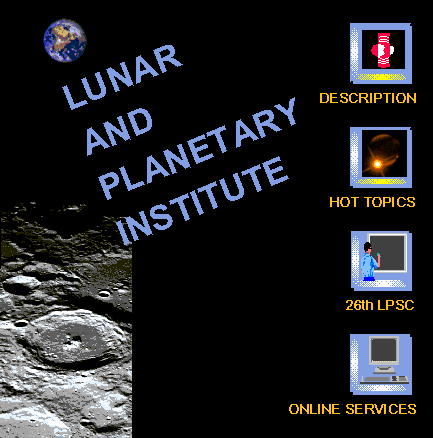
The World-Wide Web is a global hypermedia system that delivers text, graphics, sound, and video over the Internet. The best way is to think of it as a global virtual library where, with the click of a few buttons, images and text are automatically and transparently retrieved from sources around the world and displayed on your computer screen. All this is done without your having to know where the documents are stored or how they are accessed.
I will use accessing the LPI Home Page via Mosaic as an example. The URL for the LPI Home Page is:
http://www.lpi.usra.edu/lpi.html. After you have Mosaic opened on your screen, usually by typing the word mosaic or clicking on the mosaic icon in your Windows, you click on the "file" button and select the "open URL" option. Type in the URL (http://www.lpi.usra.edu/lpi.html) and hit return. The LPI Home Page should appear on your screen after a few seconds. It is a large image map with icons embedded in it. You can click on any of the four icons on the right side of the image, i.e., Description, Hot Topics, 26th LPSC, and Online Services to access information contained within the Home Page. Each click will launch you to the next level of information. If you are not using a browser that can display images, you can use the text index, which is highlighted and underlined.
Suppose you click on the Hot Topics icon: It will bring up another page of topics on your screen. If you click on Clementine Images, yet another screen appears with thumbnail images from the Clementine mission listed on the screen. Clicking on each image will bring the full image to the screen. Clicking on the word "caption" will display the image description. If you place the mouse arrow on the image and then click the right button, you will bring up a menu. With this menu, you can double the size of the image, save the image to your local disk, or rotate the image, just to name a few operations.
If you click on the 26th LPSC icon instead, the page for LPSC information will appear. Click on "Conference Announcements" to get the first, second, or third announcements. Click on "Program and Abstracts" to get the time and room number of talks. You can search for authors, speakers, and topics, and have the information displayed with or without the abstract. If you click on the "Print" button, you can have the information onscreen printed to your local printer, or you can e-mail the information to yourself by clicking on the "Mail to" option. Clicking on the "Back" button will bring up the previous page on the screen; repeating "Back" allows you to retrace your path through the Web.
Using the hypertext features of the Web, most home pages point to other home pages with related information. For example, from the LPI Home Page you can click on the highlighted text "PDS" (Planetary Data System) and the PDS Home Page will appear on your screen after a few seconds. Using this technique, you can roam the globe from continent to continent. A feature known as the "Hotlist" allows you to record the URL of places you have visited for return visits at a later date. This is equivalent to a list of frequently dialed numbers on your phone and is a handy way to get around without having to type in URLs all the time.
* NCSA Mosaic can be downloaded free for noncommercial use by anonymous ftp at ftp.ncsa.uiuc.edu. A character mode browser called Lynx is available to run on Unix, VMS, and PCs from the University of Kansas. The program can be downloaded by anonymous ftp at ftp2.cc.ukans.edu. Also, commercial services like Prodigy have an option to connect to the WWW for an hourly rate. Other commercial services like America Online and Compuserve are also planning such options later this year.
--Kin Leung
(Mr. Leung is the LPI Computer Systems Manager and the Project Manager of LPI Online.)
We'll start our survey with the LPI Home Page, where you will currently find announcements of upcoming conferences and of the Undergraduate Summer intern program, a collection of databases and images, and on-line versions of recent LPI Bulletins.
http://www.lpi.usra.edu/lpi.html
The NASA Home Page (includes connections to home pages for the various field centers)
http://www.gsfc.nasa.gov/NASA_homepage.html
Guide to NASA Online Resources
http://naic.nasa.gov/naic/guide/
NASA Public Affairs
http://www.gsfc.nasa.gov/hqpao/hqpao_home.html
Recent News from JPL
http://www.jpl.nasa.gov/jplnews.html
Hubble Space Telescope Images
http://www.stsci.edu/EPA/Recent.html
The Planetary Data System Home Page (includes connections to the various PDS nodes)
http://stardust.jpl.nasa.gov/
PDS Geoscience Node
http://wwwpds.wustl.edu/
PDS Imaging Node
http://cdwings.jpl.nasa.gov/PDS/
The National Space Science Data Center
http://nssdc.gsfc.nasa.gov/planetary/planetary_home.html
The National Geophysical Data Center
http://www.ngdc.noaa.gov/ngdc.html
The National Center for Atmospheric Research
http://http.ucar.edu/metapage.html
Shuttle Imaging Radar (SIR-C)
http://edcwww.cr.usgs.gov/landdaac/sir-c/sir-c.html
Johnson Space Center Digital Image Collection (Earth Observations and Manned Space Flight Press Release Images)
http://images.jsc.nasa.gov/html/home.htm
Many recent and upcoming NASA planetary missions have Web home pages, including the Magellan Project
http://newproducts.jpl.nasa.gov/magellan/mgn.html
Magellan Image Browser
http://delcano.mit.edu/http/midr-help.html
Clementine Project
http://www.nrl.navy.mil/clementine/clementine.html
http://clementine.s1.gov/
Clementine Image Browser
http://www.nrl.navy.mil/clementine/clib
Project Galileo
http://www.jpl.nasa.gov/galileo/
Mars Global Surveyor Mission
http://www.jpl.nasa.gov/mgs.html
Mars Pathfinder Project
http://mpfwww.jpl.nasa.gov/
Near Earth Asteroid Rendezvous Mission
http://grant.jhuapl.edu/NEAR/
A number of sites provide access to imagery from the Comet Shoemaker-Levy 9 impacts with Jupiter. These include
http://www.stsci.edu/EPA/Comet.html
http://newproducts.jpl.nasa.gov/sl9/sl9.html
Hyperlinks to these addresses are available on the LPI Home Page in the "Online Services" section under the heading "Useful Planetary Science WWW Sites." This survey has undoubtedly omitted other sites of interest to the planetary science community. If you know of other Web sites that should be brought to the attention of LPI Bulletin readers, send the http address to thompson@lpi.usra.edu for inclusion in a future issue of the Bulletin. Happy Webbing!
--Walter S. Kiefer, LPI